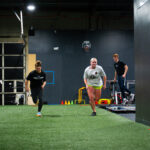Speed and Agility Training for Youth Athletes
Introducing speed and agility training at a young age builds a strong athletic foundation. It improves motor skills, boosts confidence, and encourages healthy habits. Whether your child plays soccer, basketball, or just enjoys being active, speed and agility training can give them an edge.
Why Youth Athletes Need Speed and Agility Training
Developing speed and agility early helps young athletes move better and safer. These skills increase reaction time, improve coordination, and reduce injury risk.
Even better, training at a young age fosters discipline and encourages a lifelong love for movement. According to Healthline, physical activity strengthens growing muscles and bones while supporting mental well-being.
Key Benefits for Young Athletes
Let’s look at how youth benefit from speed and agility training:
1. Better Motor Skills
Kids naturally learn through movement. Agility drills fine-tune their balance, footwork, and body control.
2. Improved Focus and Discipline
Structured drills help kids concentrate and follow directions. These are valuable skills on and off the field.
3. Increased Confidence
When young athletes see their speed and agility improve, they feel more confident. This can boost their overall performance and self-esteem.
4. Injury Prevention
Training improves coordination, balance, and flexibility. These qualities help prevent common injuries from trips, falls, or sudden movements.
Simple Speed and Agility Drills for Kids
Training should be fun, safe, and age-appropriate. Here are some effective drills:
Hopscotch Ladder
Use an agility ladder and combine it with hopping patterns. This keeps things playful while improving foot speed.
Cone Weaving
Set up cones in a zig-zag line. Kids can sprint or shuffle through them to practice change of direction and quickness.
Tag Variations
Games like freeze tag can be modified with boundaries and time limits to train sprinting and stopping quickly.
Relay Races
Add cone touches or hurdles to relay races. They encourage teamwork while promoting speed and agility.
Keep sessions short—about 20 to 30 minutes—and always include a fun warm-up and cool-down.
How Often Should Youth Train?
Two to three speed and agility training sessions a week are enough for most youth athletes. Keep it enjoyable to maintain motivation.
Mix in play-based activities and avoid too much repetition. A varied, engaging routine helps kids stick with it and stay enthusiastic.
Safety Tips for Youth Training
Youth athletes are still growing. Training should never be too intense or rigid. Here are some essential safety tips:
-
Prioritize proper form over speed
-
Always warm up and cool down
-
Ensure drills are age-appropriate
-
Stay hydrated and take breaks
-
Supervise closely for feedback and encouragement
Also, make sure they wear the right shoes and use soft, flat surfaces to reduce impact.
Integrating Speed and Agility Training Into Team Practices
Coaches can introduce speed and agility training as part of regular team warm-ups or skill drills. Adding cones, ladders, and light jumps into practice builds agility without needing separate sessions.
At Next Level Athletics USA, coaches understand how to blend fun with progress. Their programs show how effective youth agility training can be when properly structured.
Building Athletic Habits for Life
The ultimate goal isn’t just short-term performance. It’s building lifelong habits of movement and fitness. Youth speed and agility training encourages kids to stay active, develop discipline, and enjoy physical challenges.
Parents and coaches can support young athletes by offering praise, making drills enjoyable, and keeping pressure low. This helps kids build a positive relationship with sports and self-improvement.
Final Thoughts
Speed and agility training gives youth athletes a head start. It enhances performance, reduces injuries, and builds confidence—all while keeping the process fun and engaging.
By using playful drills, promoting consistency, and focusing on safety, you’ll help young athletes thrive both in sports and life. Start early, keep it fun, and celebrate every step forward.


Recent Comments